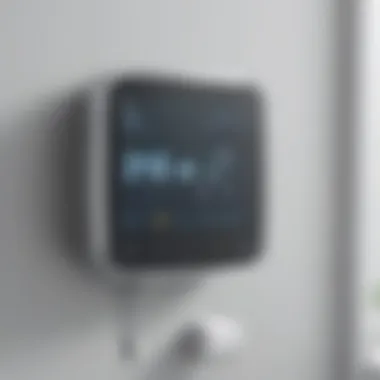Optimizing Online Security: Room Temperature Monitoring System Essentials


Overview of Cyber Security Threats
In the realm of online security, being cognizant of the myriad cyber threats is imperative for safeguarding sensitive information. Cyber threats come in various forms, such as malware, phishing, and ransomware, each posing unique risks to data integrity and system security. Understanding the prevalent types of cyber threats empowers individuals to bolster their defense mechanisms effectively. Additionally, reflecting on statistics related to cyber attacks sheds light on the magnitude of the ongoing cybersecurity landscape, emphasizing the need for robust protective measures. Real-life examples of security breaches serve as cautionary tales, highlighting the critical importance of proactive security protocols.
Introduction
This section delves deep into the critical topic of enhancing online security through a room temperature monitoring system. Online security is a paramount concern for organizations handling sensitive data and equipment. The temperature within a room can greatly impact the performance and longevity of hardware, making it crucial to monitor and maintain optimal conditions consistently. By exploring the significance of room temperature monitoring, this article aims to provide a detailed understanding of how this aspect plays a vital role in bolstering online security measures.
Significance of Room Temperature Monitoring
Impact on Equipment Performance
Room temperature monitoring directly influences the performance of equipment housed within a particular space. Fluctuations in temperature can lead to overheating, which in turn can degrade hardware components and potentially cause malfunctions. The stability of room temperature is imperative for ensuring that equipment functions optimally, maximizing its operational lifespan. Monitoring temperature effectively can mitigate the risks associated with performance degradation due to external environmental factors.
Role in Data Protection
Apart from impacting equipment functionality, room temperature also plays a crucial role in data protection. Extreme temperatures can damage storage devices, corrupt data, and compromise the integrity of sensitive information. Monitoring the temperature of the environment where data storage systems are kept is essential for safeguarding against potential loss or unauthorized access. A reliable monitoring system contributes significantly to maintaining the integrity and security of stored data, forming a foundational aspect of overall data protection strategies.
Overview of Room Temperature Monitoring Systems
Types of Monitoring Devices
There are various types of monitoring devices available that cater to different needs and environments. Some devices offer basic temperature sensing capabilities, while advanced systems incorporate additional features such as humidity monitoring and remote access. Choosing the right type of monitoring device depends on the specific requirements and infrastructure of the organization. Understanding the available options is crucial for selecting a system that aligns with the monitoring objectives effectively.
Functionality and Features
The functionality and features of room temperature monitoring systems vary widely, ranging from basic temperature alerts to sophisticated data analysis and reporting capabilities. Advanced systems may include predictive maintenance features, integration with existing control systems, and customizable alarm thresholds. Evaluating the functionalities and features of different systems is essential for identifying a solution that not only meets current requirements but also offers scalability and adaptability for future needs.


Benefits of Implementing a System
Prevention of Overheating
Preventing overheating is one of the primary benefits of implementing a room temperature monitoring system. By continuously monitoring temperature levels, organizations can identify potential overheating issues promptly and take preventive measures to mitigate risks. This proactive approach helps in preventing hardware damage, reducing downtime, and maintaining operational continuity.
Early Detection of Fluctuations
Early detection of temperature fluctuations is crucial for preventing adverse effects on equipment and data storage systems. A monitoring system that provides real-time alerts and trend analysis allows quick response to any deviations from the optimal temperature range. Timely detection of fluctuations enables organizations to address issues before they escalate, minimizing the chances of equipment failure and data loss. The ability to detect and respond swiftly to temperature changes enhances the overall resilience of online security measures.
Importance of Consistent Temperatures
Consistent room temperatures play a crucial role in ensuring the optimal performance of sensitive equipment and data storage systems. Maintaining a stable environment safeguards these components from potential risks that could arise due to temperature fluctuations. By keeping temperatures within a specified range, organizations can significantly reduce the chances of hardware failure and data loss, thereby enhancing their overall online security measures. When the temperature remains consistent, it aids in minimizing wear and tear on equipment while also extending their lifespan.
Impact on Hardware
Minimizing Wear and Tear:
In the context of temperature monitoring systems, the aspect of minimizing wear and tear is essential for preserving the operational efficiency of hardware components. By ensuring that devices are not exposed to extreme temperature variations, the system can prevent unnecessary strain on internal mechanisms, which could lead to malfunctions or breakdowns. Through the consistent regulation of temperatures, wear and tear on hardware components are minimized, promoting longevity and sustained performance. This feature is particularly advantageous in preventing abrupt failure of critical equipment and maintaining a reliable operational environment.
Enhancing Equipment Lifespan:
Enhancing equipment lifespan is a key objective achieved through the implementation of a room temperature monitoring system. By creating an environment with consistent temperatures, the system contributes to reducing the stress and degradation experienced by hardware components over time. This proactive approach helps in extending the operational lifespan of equipment, optimizing their functionality, and ensuring ongoing reliability. The unique feature of enhancing equipment lifespan through temperature monitoring lies in its ability to mitigate risks associated with premature hardware failures, improving overall system efficiency and cost-effectiveness.
Influence on Storage Devices
Preventing Corrupt Data:
The prevention of corrupt data is a critical aspect influenced by maintaining consistent room temperatures. Fluctuating temperatures can lead to data corruption within storage devices, compromising the integrity of critical information. By implementing a room temperature monitoring system, organizations can safeguard data repositories from such risks, ensuring the preservation of accurate and reliable data. This approach minimizes the potential for data loss or inaccuracies, enhancing the overall security and functionality of storage systems.


Reducing Risk of Malfunctions:
Reducing the risk of malfunctions is another significant benefit derived from consistent temperature management in storage devices. Fluctuations in temperature levels can trigger malfunctions within storage hardware, leading to operational disruptions or system failures. By stabilizing temperatures, the monitoring system works to mitigate these risks, enhancing the reliability and continuity of storage operations. The unique feature of reducing the risk of malfunctions through temperature monitoring lies in its capacity to uphold the performance and longevity of storage devices, ensuring seamless data management processes.
Choosing the Right Monitoring System
Room temperature monitoring systems play a crucial role in ensuring the optimal functioning of sensitive equipment and data storage. Choosing the right monitoring system is paramount to maintaining a secure environment that minimizes the risks of hardware failure and data loss. When selecting a monitoring system, several key elements need to be considered to effectively enhance online security measures. One of the primary considerations is the accuracy and precision of the system. The system's ability to provide real-time, accurate readings of room temperatures is essential for proactive management of potential risks. Additionally, the integration of the monitoring system with the existing infrastructure is vital for seamless implementation and compatibility. Ensuring that the monitoring system can integrate smoothly with current technology setups enhances its effectiveness in maintaining secure conditions. Furthermore, scalability and customization are essential factors to consider when choosing a monitoring system. The system should have the capability to adapt to the organization's growth and specific needs, allowing for optimal performance tailored to unique requirements.
Factors to Consider
Accuracy and Precision
Accuracy and precision are fundamental aspects of any monitoring system, especially concerning online security through room temperature monitoring. The system's accuracy in recording temperature variations and its precision in delivering reliable data are crucial for effective monitoring and maintenance. The ability to accurately detect even minor fluctuations ensures timely response to any potential threats. Precision contributes to the system's overall reliability, providing confidence in the data readings and subsequent actions taken to maintain secure conditions.
Integration with Existing Infrastructure
Integration with existing infrastructure is a significant consideration when selecting a room temperature monitoring system. Compatibility with current systems and technologies streamlines the implementation process and enhances the system's functionality. A monitoring system that seamlessly integrates with the organization's infrastructure not only improves efficiency but also ensures the continuity of operations without disruptions. This integration fosters a cohesive approach to online security, combining monitoring efforts with existing protocols for comprehensive protection.
Scalability and Customization
Adaptability to Growth
Scalability and adaptability to growth are crucial factors to consider in a monitoring system. The system should have the flexibility to accommodate an organization's expansion without compromising its monitoring capabilities. A system that can scale according to increasing monitoring requirements facilitates long-term security planning and adjustment to evolving needs. Adapting to growth ensures that the monitoring system remains effective and reliable in safeguarding sensitive equipment and data.
Configurability for Specific Needs
Customization plays a key role in tailoring the monitoring system to meet specific organizational requirements. The system's configurability to address unique needs enhances its utility in maintaining online security. Being able to customize alerts, thresholds, and monitoring parameters allows organizations to align the system with their security protocols effectively. Configurability empowers users to fine-tune the monitoring system according to their distinct operational demands, maximizing its efficiency and relevance for ensuring secure conditions.
Implementation Best Practices


In the realm of room temperature monitoring systems, adhering to implementation best practices is paramount for ensuring the efficacy and reliability of the system. This section delves into the crucial aspects that play a pivotal role in the successful deployment of such systems. One of the primary benefits of following best practices is the optimization of system performance and accuracy. By meticulously adhering to installation guidelines and setup protocols, organizations can guarantee that their monitoring system functions at peak efficiency, thereby minimizing the likelihood of errors or malfunctions. Moreover, emphasizing best practices facilitates seamless integration with existing infrastructure, fostering a cohesive and synchronized operational environment.
Installation and Setup Tips
Placement of Sensors
The placement of sensors is a critical component in the implementation of a room temperature monitoring system. Proper positioning of sensors is essential for acquiring accurate and reliable data regarding temperature variations within the monitored environment. One key characteristic of sensor placement is strategic positioning in areas that are prone to temperature fluctuations or hotspots. This strategic approach allows for comprehensive coverage and real-time monitoring of temperature changes, enabling prompt detection and response to potential issues. An advantage of this approach is the proactive nature of monitoring, which helps in preventing equipment damage or downtime through early intervention. However, a potential drawback could be the initial complexity involved in determining the optimal sensor locations, which may require thorough planning and testing.
Calibration Procedures
Calibration procedures are indispensable for ensuring the precision and consistency of temperature measurements obtained through the monitoring system. The calibration process involves verifying the accuracy of sensor readings against known standards and making necessary adjustments to eliminate discrepancies. A key characteristic of calibration procedures is the periodicity of calibration checks to maintain data integrity and system reliability. Conducting regular calibrations not only enhances the accuracy of temperature readings but also prolongs the lifespan of monitoring equipment, thereby optimizing long-term operational costs. An advantage of stringent calibration practices is the assurance of data accuracy and reliability, which are fundamental in critical environments such as data centers and laboratories. However, a potential disadvantage could be the time and resources required to execute calibration routines, especially in large-scale monitoring systems.
Monitoring and Maintenance
Regular Inspections
Regular inspections form a vital component of maintaining an effective room temperature monitoring system. These inspections involve visually examining sensors, verifying connections, and assessing overall system functionality to ensure optimal performance. A key characteristic of regular inspections is the timely identification of potential issues or anomalies that may impact system operation. By conducting frequent inspections, organizations can preemptively address concerns and uphold the continuous surveillance of temperature conditions. An advantage of consistent inspections is the prevention of system downtime and the mitigation of risks associated with temperature fluctuations. Nevertheless, a downside to this practice could be the requirement for dedicated personnel and resources to conduct routine checks, which might pose logistical challenges in resource-constrained settings.
Alarm System Configuration
The configuration of an alarm system serves as a pivotal aspect in the responsiveness and efficacy of a temperature monitoring setup. Properly configuring alarm systems enables timely notifications and alerts in the event of temperature deviations beyond predefined thresholds. A key characteristic of alarm system configuration is the customization of threshold limits based on specific temperature tolerances and criticality levels. This tailored approach ensures that alarms are triggered only when necessary, mitigating false alarms or unnecessary disruptions. An advantage of meticulous alarm system configuration is the enhancement of system responsiveness and the facilitation of prompt corrective actions in urgent situations. However, a potential disadvantage could be the complexity of fine-tuning alarm settings to strike a balance between sensitivity and practicality, which may require iterative adjustments and refinement.
This section elucidates the fundamental aspects of implementation best practices in room temperature monitoring systems. By meticulously addressing installation guidelines, calibration procedures, monitoring practices, and alarm configurations, organizations can fortify their online security measures through proactive temperature management strategies.
Conclusion
Ensuring Robust Online Security
Role of Temperature Monitoring
Undoubtedly, the Role of Temperature Monitoring stands out as a crucial facet in the holistic approach towards bolstering online security. This indispensable element functions as the frontline defense mechanism in safeguarding the integrity and functionality of sensitive equipment housed within data centers. The key characteristic of Temperature Monitoring lies in its ability to provide real-time data on environmental conditions, ensuring proactive measures can be promptly instituted to maintain optimal operating parameters. Its popularity stems from the fact that it offers an unparalleled level of surveillance over room temperatures, enabling organizations to preemptively address any deviations that could potentially jeopardize the efficacy of their hardware infrastructure. A unique feature of Temperature Monitoring is its capacity to integrate seamlessly with existing monitoring systems, augmenting their capabilities and offering a comprehensive view of environmental variables. Although it presents notable advantages in enhancing online security, some organizations may find the initial investment in such technology to be a deterrent; however, the long-term benefits far outweigh any short-term cost considerations, making it an indispensable asset in fortifying digital defense strategies within this article.
Continuous Improvement Strategies
The pursuit of Continuous Improvement Strategies is integral to the sustenance and advancement of online security protocols within the digital landscape. This proactive approach emphasizes the iterative refinement of existing security measures, accentuating adaptability and responsiveness to emerging threats. The key characteristic of Continuous Improvement Strategies lies in its emphasis on integrating feedback loops and performance metrics to gauge the efficacy of implemented security measures continually. This adaptive framework is a preferred choice for organizations seeking to fortify their online security posture, as it fosters a culture of resilience and evolution. A unique feature of Continuous Improvement Strategies is its scalability and flexibility, allowing organizations to tailor security protocols based on evolving threats and regulatory requirements. While it presents numerous advantages in ameliorating online security frameworks, organizations must also be cognizant of the resource allocation and organizational commitment required to sustain ongoing improvement efforts. However, the intrinsic value derived from a proactive and adaptive security approach positions Continuous Improvement Strategies as an indispensable tool in the arsenal of organizations striving to safeguard their digital assets effectively within the narrative of this article.







